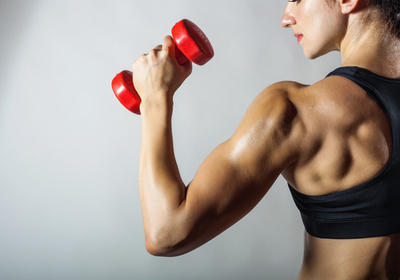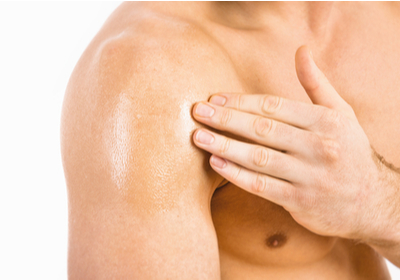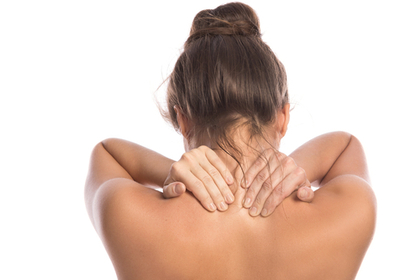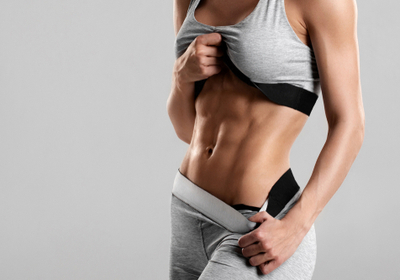VIDEO
Plank with Opposite Arm and Leg Lifts, Downward Facing Dog Variation, Crab Walk, Side Plank Variation
- Core
- Arms
- Back
- Legs
- Abs
- Triceps
Level:Intermediate
Trainer:
Equipment:No Equipment
Plank with Opposite Arm and Leg Lifts, Downward Facing Dog Variation, Crab Walk, Side Plank Variation
- Core
- Arms
- Back
- Legs
- Abs
- Triceps
Level:Intermediate
Trainer:
Equipment:No Equipment
1. Start from a high-plank position. Lift your left leg and right hand. Then put them down on a mat and lift the right leg and your right arm. 2.Start from a high-plank position. Without moving your feet and hands, lift your hips up and back. Hold on this position for 1-3 minutes. 3.Sit on the floor with your feet hip-distance apart and your arms behind your back. Lift your hips off the floor tightening your abs. Moving the left hand following the right foot and then your right hand - by the left foot, start walking forward. 4.Lie down on your fitness mat on the left side. Position your elbow directly under your right shoulder. Stuck your legs, knees, ankles, and feet together.
save to ...
RECOMMENDED FOR YOU
- Core
- Arms
- Legs
Duaration: 00:15
save to playlist
- Core
- Arms
- Legs
Duaration: 00:15
save to playlist
- Core
- Biceps
- Triceps
Duaration: 00:15
save to playlist
- Core
- Arms
- Legs
Duaration: 00:15
save to playlist
- Abs
- Biceps
- Triceps
Duaration: 00:15
save to playlist
- Core
- Back
- Abs
Duaration: 00:15
save to playlist
- Core
- Legs
- Abs
Duaration: 00:15
save to playlist
- Core
- Legs
- Abs
Duaration: 00:15
save to playlist
- Core
- Arms
- Legs
Duaration: 00:13
save to playlist
- Core
- Arms
- Legs
Duaration: 00:15
save to playlist
- Arms
- Back
- Legs
Duaration: 00:15
save to playlist
- Core
- Arms
- Back
Duaration: 00:15
save to playlist
- Arms
- Back
- Abs
Duaration: 00:15
save to playlist
- Core
- Trapezius
- Lower Back
Duaration: 00:15
save to playlist
- Core
- Back
- Legs
Duaration: 00:15
save to playlist
Blog
The Kardashians have created many beauty trends, one of which is having beautiful buttocks. So, in this article, we'll talk about building great gluteus muscles so you can look as attractive as Kim, Kourtney, and Khloe. Let's begin by looking at the anatomy. The glutes are made up of three main parts.
The gluteal maximum muscles, which are the largest muscles in the body, help to maintain balance when walking and running. They allow your legs to move sideways and are also responsible for contouring the shape of the buttocks.
The gluteus medius is overlaid in part by the gluteus maximus and is located at the top of the pelvis. It is involved in leg extension, lateral flexion, and body stabilization during the movement.
Finally, below is the gluteus minimus. Both are in charge of leg induction and body stabilization, as well as shaping the thigh line.
Training for the glutes
Building your glute muscles isn't easy, particularly when you're on a tight schedule. However, by working out at least three times a week and never giving up, you will quickly reach your goal. To help you achieve your goals, we've compiled the best exercises for your gluteus muscle development.
Deep squat with a barbell
This is one of the basic exercises that help to develop this muscle effectively. From the starting position - with your feet apart - lower your pelvis below the knees. Keep your lower back straight and make sure the knees do not go over your feet. Spreading your legs wider apart puts more pressure on your hips.
Romanian deadlifts
Stand up straight with a slight bend at the waist. Holding the dumbbells in both hands, bend over and pull your pelvis backward. Reaching a point just below your knees, return to start.
Dumbbell split squat
Exercise with a straight back and one leg stepping forward while the other leg is thrown into a brace behind you. Squat down and perform the exercise with both legs.
Back lunges
From the standing position, take a large step backward and drop down to form a bent-over position. Return to start and repeat this exercise for the other leg. Make sure your knee is bent at a right angle and not sticking out past your toes, do 20-30 reps. It is important to step backward precisely, maintaining rhythm and balance.
Having great gluteus is everyone's dream, and luckily, developing these muscles isn't difficult if you know the right exercises. So why not take advantage of our tips and start working towards your goal right now?
Read more
While working on their arms, many people concentrate on the biceps and completely forget about the workouts for the triceps. Of course, working on your triceps is super important since you have to develop these muscles in order to have strong and relief arms. So how to train your triceps and grow beautiful muscles? This is the question we’ll try to answer in this article.
Is It Difficult to Develop Triceps?
Many people believe that growing triceps is extremely challenging, but luckily, it’s not true. The thing is anatomically triceps are rather easy to train and eventually grow. At the same time, these muscles easily get sore after training and therefore impact your entire arm workout routine since you aren’t able to do certain exercises. In general, working on triceps is not as difficult as many people think, yet it still requires some time and effort.
How Long Does It Take To Grow Triceps?
The amount of time it takes to develop triceps depends on what you are striving for as well as what you start with. For example, if you are skinny and you just want to make your arms more fit, a few months will be enough. In case you want to grow really pronounced muscles, you might need from 6 to 12 months. At the same time, if you have some extra pounds, working on your triceps can take longer since you also have to lose weight. As you can see, every situation is different, so it’s hard to give you the precise amount of time you’ll need to grow your triceps.
How Often Should I Exercise?
To grow any muscle group as well as be healthy and fit, you need to work out at least three times a week. Of course, you need to understand that even if you try to develop triceps, you still have to work on other muscle groups, so all the muscles in your body are harmoniously developed. In general, most trainers recommend doing 4-6 exercises for triceps during your workouts. Each exercise has to be done in 2-3 sets, while the set has to have 10-15 repetitions. In addition to that, you have to keep in mind that you should start with simple workouts and gradually move towards more advanced ones to see the results of your training sessions.
Exercises for Triceps
Of course, many of you are interested in the best workouts for developing triceps muscles. Well, first of all, you can head to our video sessions and rain with our experienced coaches. Secondly, you can check out the following workouts:
Close-grip bench press
Tricep dips
Lying triceps extension
Isolated triceps extension
Cable rope tricep pushdown
JM press
Diamond push-ups
Underhand cable pushdowns
One-arm overhead extension
Dumbbell tricep extensions
Bench dip
Dumbbell floor press
Push-up
One arm kettlebell floor press
45-degree incline dumbbell chest press
Wrapping Up
Gorgeous triceps is a dream come true for any fitness enthusiast and professional athlete, so no wonder why these exercises are so popular. Head to our videos section and explore triceps workouts from our instructors.
Read more
Many people mistakenly believe that developing shoulder muscles is not important. Well, obviously, it’s not true. So why is it important to work on the shoulder muscles and how to improve them is the topic of this article.
What Are Shoulder Muscles?
Shoulder muscles are basically the muscles that provide shoulder movement. These muscles are voluntary, meaning we control their work. The main functions of the shoulder muscles are the following:
Holding the shoulder joint and its bones in place
Allowing your shoulder joint to rotate
Providing the ability to move your arms forward, up, and down
Shoulder joint protection
As you can see, these muscles are extremely important for performing basic things such as lifting objects or holding something. In addition to that, these muscles are rather important for certain sports that require lots of jerky movements in the shoulder area. For example, dancers, basketball players, tennis players, swimmers, and others. All in all, shoulder muscles do a lot of work, which is why we have to develop them.
Why Do I Need to Work on My Shoulder Muscles?
We have already partly answered this question above, but we’ll give you a more detailed answer just to make things clear. First of all, strong shoulder muscles are a must for many athletes, dancers, and fitness enthusiasts who actively involve arms and shoulders in their activities. The thing is, these muscles are rather fragile, and jerky movements can lead to an injury. At the same time, if one works on these muscles regularly, they significantly lower the risks of possible injuries. But what about people who are not professional dancers or athletes? Well, even if you are not a pro athlete, you still need to go to the gym at least a few times a week to maintain your health, and simple workouts can also cause an injury if you have weak shoulder muscles. So as you might have already understood that working on the shoulder muscles is a must for everyone.
Exercises for Improving Shoulder Muscles
So what workouts can you do to improve your shoulders? Well, why don’t you consider the following ones:
Push-ups
Barbell overhead press
One-hand push-ups
Half-kneeling landmine press
Dumbbell shrugs
Arnold press
Sideways dumbbells
Push press
Barbell press
Wide-grip seated row
Final Thoughts
Stronger muscles minimize the risks of having severe injuries while working out or even doing your regular chores. So no matter if you are a pro athlete or dancer or just a regular person, you should consider working on your shoulder muscles.
Read more
Trapezius muscles are often underestimated, and many people don’t pay much attention to them while working out. However, it is a huge mistake because these muscles are extremely important for the right posture as well as back health. So in this article, we’ll talk about trapezius muscles and how to develop them.
Why Do I Need to Work on Trapezius Muscles?
The trapezius is a part of the upper back which helps us to maintain the right posture. The muscle group consists of three different parts, which are top, medium, and bottom. Together with the muscles of the neck, the trapezius is responsible for the right posture. The upper part of this muscle is responsible for the rise of the shoulder as well as the ability to lift arms. The lower one - is for lowering shoulders and arms. At the same time, the middle one is needed for blade movement. As you can see, this muscle group is responsible for many basic functions, which is why developing the trapezius muscles is extremely important for everyone, especially for those people who have some problems with their posture.
How Often Should I Do Trapezius Workouts?
Ideally, you have to include at least 2-3 trapezius exercises in each workout session. At the same time, you have to work out 3 times a week. In some cases, it’s better to have 4 training sessions per week. In case you have some issues with your posture and you cannot keep your back straight because your spine muscles (especially trapezius) are weak, we recommend doing at least a few exercises for trapezius muscles every day.
Who Needs Trapezius Exercises the Most?
Of course, everybody needs to straighten their trapezius muscles, but, obviously, some people need it more than others. So who are those people? Well, here is a short list of those you must pay more attention to their trapezius muscles:
Office workers who work long hours at the desk
People who have posture problems and struggle to keep their back straight
Athletes and fitness enthusiasts who lift heavy weights
Boxers, volleyballers, basketballers, and other sportsmen who actively involve their arms in their sports activity
Dancers and gymnasts who need strong and developed back muscles
Do you belong to any of these groups? Then you better start working on your trapezius muscles now.
Best Workouts for Trapezius
Last but not least, we would like to recommend you some trapezius workouts, so here they come:
Shrug
Deadlift
Shoulder blade squeeze
Barbell row
Upright row
Reverse dumbbell flyes
Chin-up
Pull-up
Push-up
Lat-pulldown
Rear delt cable raise
High pulley cable row
Overhead farmer's walk
Y raise
Rope rear delt pull
Wrapping Up
Trapezius muscles are super important for your back health, so no matter what your occupation is or how often you work out, you still need to find at least a few minutes for some exercises for the trapezius.
Read more
Gorgeous abs are perhaps the biggest dream of all fitness enthusiasts as well as professionals. However, not many people know how to get abs and pretty often make a lot of mistakes while trying to work on their abs. Therefore, in this article, we will talk about abs and how to get them quickly and stress-free
Your Abs Are What You Eat
Not many people know it, but your diet is extremely important for achieving relief abs. Of course, it doesn’t mean that you have to starve yourself or follow weird diets, but working out is definitely not enough to achieve such a goal. The thing is to build muscles you need protein, which means that you have to include more protein into your diet. At the same time, high qualities of sugar and Natrium (salt) provoke swelling that sort of hides the relief of the muscles even if you don’t have much belly fat. Thus, to get the six-pack, you have to make your diet healthier as well as drink enough water, and together with exercising, it will help you get the body of your dreams.
Don’t Overestimate Your Abilities
Many people think that the more they exercise and the less they eat - the better. Obviously, it’s not true. You have to adequately evaluate your abilities and consider those while working out and dieting. Trust us, starving yourself and exercising for 3 hours every day won’t bring better results. It will only damage your health, both physical and mental. So don’t worry if you cannot see the results after a few weeks of training and healthy dieting, just keep going and you’ll surely reach your goal.
Core and Back Muscles Are Essential
Probably 90% of people who would like to get abs usually forget about the core muscles and work only on their abs. This is a huge mistake. As a matter of fact, to have relief abs, you have to work on your core muscles simply because these muscles are close to each other, moreover, abs are a part of the core, so it’s impossible to get relief abs without working on the core. Therefore, working on your core will significantly boost the entire process. In addition to that, you shouldn’t forget about the back muscles. You see, our posture heavily influences the way our belly looks. You have probably already seen skinny people with weird and unproportioned bellies. Well, that happens because they have weak back muscles and their spine is curved in the way that makes their bellies sort of come forward. So in order to avoid that, make sure to strengthen your back muscles too.
Best Workouts for Abs
To wrap up, we would like to list some of the best workouts for abs, core, and back. So here they come:
Plank
Diagonal twists
Deadlift
Pushups
Bent-over row
Plank push-ups
Pull-up
Crunches
TRX suspension row
Leg lifts from lying position
Lat pulldown
Final Thoughts
A stunning six-pack is the biggest dream of many fitness enthusiasts and, luckily, it’s totally possible to make it come true. So consider the things we talked about in this article and start moving toward your goal now.
Read more
SAVE TO ...





